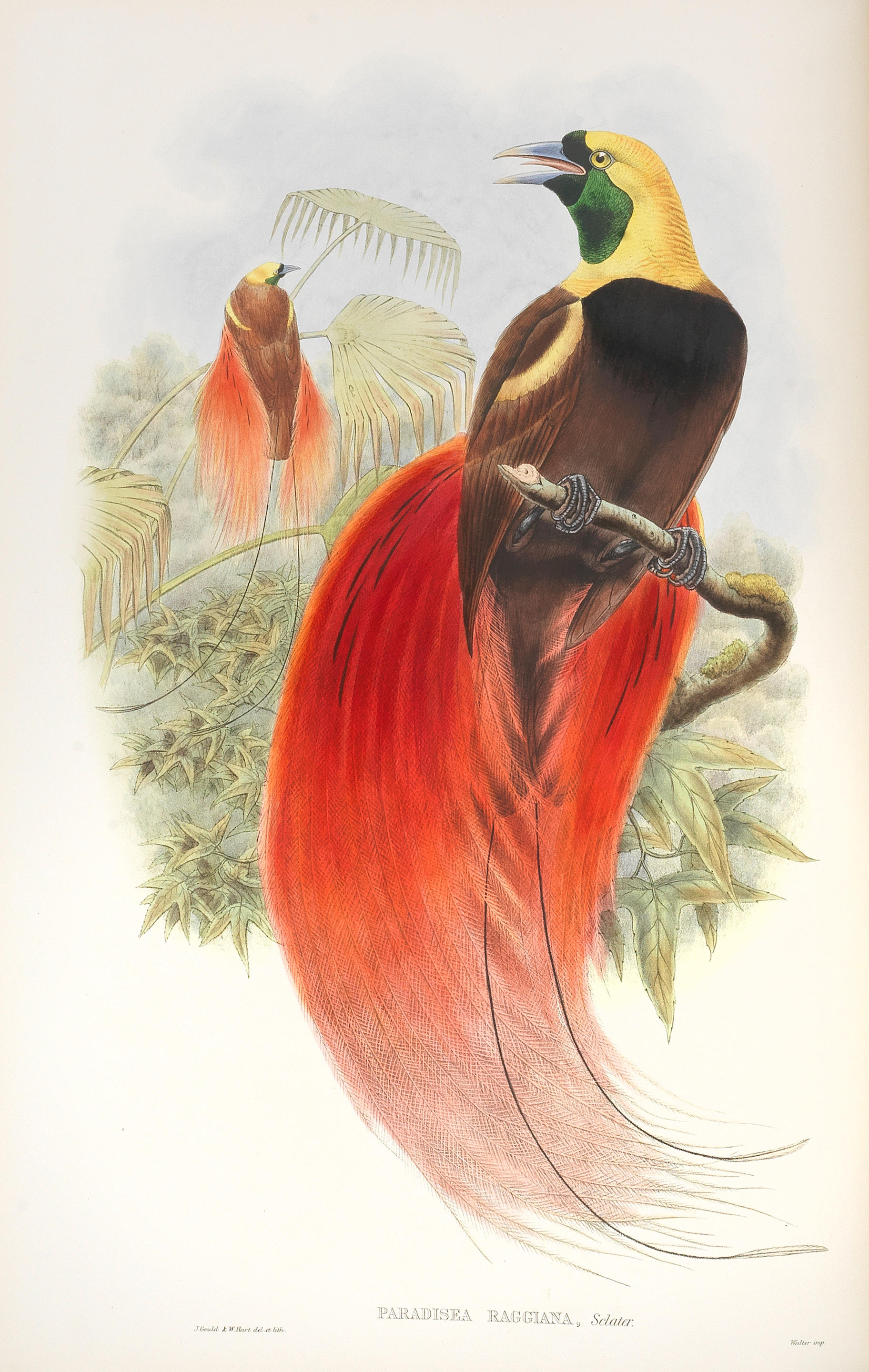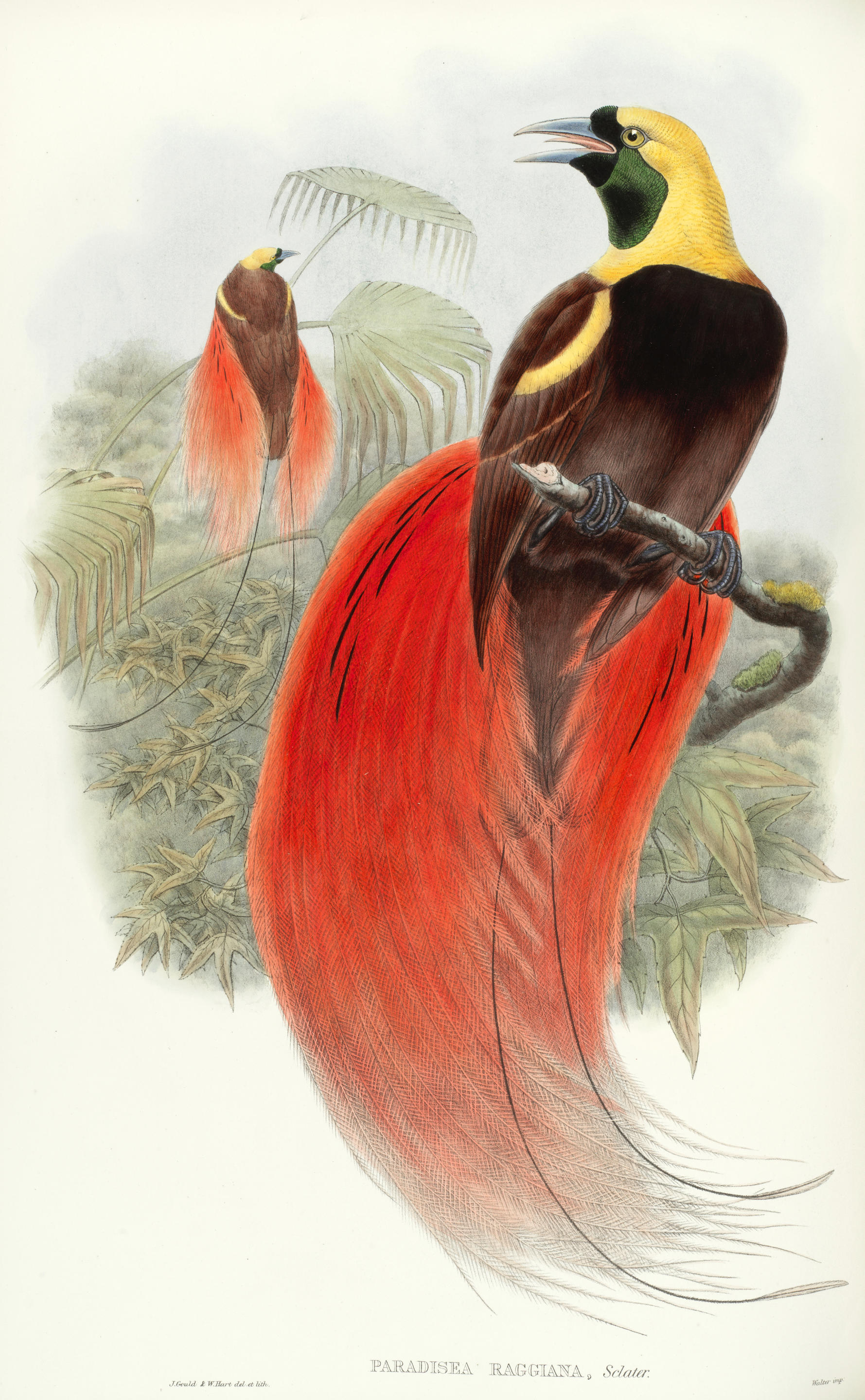GOULD, JOHN and RICHARD BOWDLER SHARPE. A Monograph of the Trochilidae, or Family of Humming-Birds, with Supplement. London: Published by the Author [1849-] 1861, Supplement: Henry Sotheran & Co. [1880-] 1887. 6 vols., large folio, 542 x 366mm. (21 3/8 x 14 3/8in.), contemporary green morocco, covers with broad gilt borders, spines gilt and gilt lettered, the Supplement binding with identical spine decoration, its side borders and spine lettering different from the main work, edges and corners rubbed, upper joint of vol. II with a starting crack, some inner joints cracked, outermost edges of some plates slightly darkened. 418 hand-colored lithographed plates, many highlighted in gold leaf overpainted with transparent oil and varnish colors, by Gould, H.C. Richter and W. Hart most printed by Hullmandel & Walton. Ayer/Zimmer, pp. 258 and 263-4; Copenhagen/Anker 177; Fine Bird Books , p. 78; McGill/Wood, p. 365; Nissen IVB 380; Sauer 16 and 29. GOULD'S "MASTERPIECE...AN INCOMPARABLE CATALOGUE AND COMPENDIUM OF BEAUTIES" ( Fine Bird Books , p. 29). Of all the bird families, the hummingbird held the greatest fascination for Gould. Most of the plates were drawn from specimens from his own collection, which he had built up thanks to a burgeoning trade in the fashionable little bird, and with the help of a pool of collectors whom he commissioned to hunt for rare or unknown varieties in the wilds of South America. (Ironically, Gould had already published over half of his study of hummingbirds before he finally saw a living specimen of one of his subjects, during his first and only visit to North America in 1857). He exhibited the collection -- which included nearly 2,000 birds from 300 different species -- in the Zoological Gardens in Regent's Park for the Great Exhibition in 1851, attracting nearly 75,000 visitors and consolidating his reputation as one of the greatest living ornithologists. Although his claim that the subscribers to the Trochilidae included "nearly all the crowned heads of Europe" (Isabella Tree, The Ruling Passion of John Gould [London 1991], p. 164) was a slight exaggeration, the magnificence of the illustrations as much as the vogue for "hummers" did attract a larger and more brilliant audience than all of his other works except The Birds of Great Britain. To illustrate the birds' iridescent plumage, Gould had used a costly technique of painting in varnish and oils over pure gold leaf, which he claimed to have invented but which he seems in reality to have borrowed with very little modification from the American hummingbird specialist William Bailey Gould died after the publication of part 1 of the Supplement . He had already supervised the preparation of many of the plates, and the project was completed by Sharpe for the text, W. Hart who did the drawings, lithographs and coloring for the 58 remaining plates, and the ornithologist Osbert Salvin who directed the general production. Soon after Gould's death his bird collections, which by then included 5378 hummingbirds, were purchased by the Zoological Society, and are now part of the British Museum's natural history collections. (6)
GOULD, JOHN and RICHARD BOWDLER SHARPE. A Monograph of the Trochilidae, or Family of Humming-Birds, with Supplement. London: Published by the Author [1849-] 1861, Supplement: Henry Sotheran & Co. [1880-] 1887. 6 vols., large folio, 542 x 366mm. (21 3/8 x 14 3/8in.), contemporary green morocco, covers with broad gilt borders, spines gilt and gilt lettered, the Supplement binding with identical spine decoration, its side borders and spine lettering different from the main work, edges and corners rubbed, upper joint of vol. II with a starting crack, some inner joints cracked, outermost edges of some plates slightly darkened. 418 hand-colored lithographed plates, many highlighted in gold leaf overpainted with transparent oil and varnish colors, by Gould, H.C. Richter and W. Hart most printed by Hullmandel & Walton. Ayer/Zimmer, pp. 258 and 263-4; Copenhagen/Anker 177; Fine Bird Books , p. 78; McGill/Wood, p. 365; Nissen IVB 380; Sauer 16 and 29. GOULD'S "MASTERPIECE...AN INCOMPARABLE CATALOGUE AND COMPENDIUM OF BEAUTIES" ( Fine Bird Books , p. 29). Of all the bird families, the hummingbird held the greatest fascination for Gould. Most of the plates were drawn from specimens from his own collection, which he had built up thanks to a burgeoning trade in the fashionable little bird, and with the help of a pool of collectors whom he commissioned to hunt for rare or unknown varieties in the wilds of South America. (Ironically, Gould had already published over half of his study of hummingbirds before he finally saw a living specimen of one of his subjects, during his first and only visit to North America in 1857). He exhibited the collection -- which included nearly 2,000 birds from 300 different species -- in the Zoological Gardens in Regent's Park for the Great Exhibition in 1851, attracting nearly 75,000 visitors and consolidating his reputation as one of the greatest living ornithologists. Although his claim that the subscribers to the Trochilidae included "nearly all the crowned heads of Europe" (Isabella Tree, The Ruling Passion of John Gould [London 1991], p. 164) was a slight exaggeration, the magnificence of the illustrations as much as the vogue for "hummers" did attract a larger and more brilliant audience than all of his other works except The Birds of Great Britain. To illustrate the birds' iridescent plumage, Gould had used a costly technique of painting in varnish and oils over pure gold leaf, which he claimed to have invented but which he seems in reality to have borrowed with very little modification from the American hummingbird specialist William Bailey Gould died after the publication of part 1 of the Supplement . He had already supervised the preparation of many of the plates, and the project was completed by Sharpe for the text, W. Hart who did the drawings, lithographs and coloring for the 58 remaining plates, and the ornithologist Osbert Salvin who directed the general production. Soon after Gould's death his bird collections, which by then included 5378 hummingbirds, were purchased by the Zoological Society, and are now part of the British Museum's natural history collections. (6)











.jpg)
.jpg)


Testen Sie LotSearch und seine Premium-Features 7 Tage - ohne Kosten!
Lassen Sie sich automatisch über neue Objekte in kommenden Auktionen benachrichtigen.
Suchauftrag anlegen